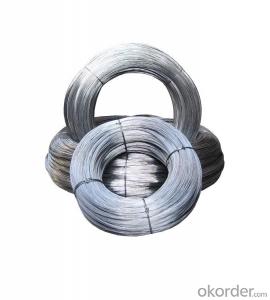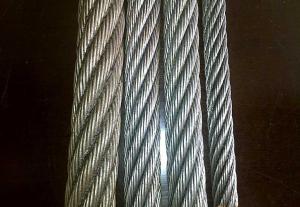High Carbon Steel Wire for Flexible Duct,Mattress Spring,Brushes And Ropes Production
- Loading Port:
- China main port
- Payment Terms:
- TT OR LC
- Min Order Qty:
- 1 m.t.
- Supply Capability:
- 1 m.t./month
OKorder Service Pledge
OKorder Financial Service
You Might Also Like
Quick Details
| Steel Grade: | Q235 Q195 45# 50# 77B 82B | Standard: | AISI,ASTM,BS,DIN,GB,JIS | Wire Gauge: | 0.2mm--13mm |
| Place of Origin: | Tianjin China (Mainland) | Type: | Galvanized | Application: | Construction package |
| Alloy Or Not: | Non-alloy | Special Use: | Free Cutting Steel | Model Number: | Q235 |
| Brand Name: | SJT | Certification: | BV ISO SGS | Tensile strength: | Above 1300Mpa |
| Price term: | FOB CFR CIF |
Packaging & Delivery
| Packaging Detail: | Standard export packing or according to the requirements. |
| Delivery Detail: | Within 20 days after receiving the deposit or the copy of L/C |
Specifications
High Carbon Steel Wire for Flexible Duct,Mattress Spring,Brushes And Ropes Production
1.Material:Q195,Q235etc ;
2.High quality
1.specification
| Material | 45#, 50#, 65#, 70#, ,77B, 82B, |
| Diameter | 0.2mm-13mm |
| Standard | DIN 17223, GB4357-2009, DIN EN 10270 |
| Weight | According to the customers' requirements |
| Uses | To produce springs, steel wire ropes, brush and other uses |
| Packing | Coils Packing, spools packing, or according to the customers' requirements |
Tensile strength of steel wire | |||||
Wire Diameter(mm) | Tensile Strength(Mpa) | Wire Diameter(mm) | Tensile Strength(Mpa) | ||
Grade B | Grade C | Grade B | Grade C | ||
0.40 | 1910-2300 | 2250-2650 | 1.40 | 1620-1910 | 1860-2210 |
0.45 | 1860-2260 | 2200-2600 | 1.60 | 1570-1860 | 1810-2160 |
0.50 | 1860-2260 | 2200-2600 | 1.80 | 1520-1810 | 1760-2110 |
0.55 | 1810-2210 | 2200-2550 | 2.00 | 1470-1760 | 1710-2010 |
0.60 | 1760-2160 | 2110-2500 | 2.20 | 1420-1710 | 1660-1960 |
0.65 | 1760-2160 | 2110-2500 | 2.80 | 1370-1670 | 1620-1910 |
0.70 | 1710-2110 | 2060-2450 | 3.00 | 1370-1670 | 1570-1860 |
0.80 | 1710-2060 | 2010-2400 | 3.20 | 1320-1620 | 1570-1810 |
0.90 | 1710-2060 | 2010-2350 | 4.00 | 1320-1620 | 1520-1760 |
1.00 | 1660-2010 | 1960-2300 | |||
1.20 | 1620-1960 | 1910-2250 | |||
- Q: What does the quot;Hstand for in quot;AWG 34Hwire?Also, would Heavy Poly Nylon magnetic wire be considered enameled?
- Magnet wire is often called varnished or enameled, but it is actually insulated with a thin coating of insulating material designed specifically for the purpose. I assume that heavy poly nylon material is one of those materials. The H is probably the temperature class of the insulation. Class H insulation is rated to operate at up to 180 degrees C. Edit 1 The H could also stand for heavy as in the heavy build or double build terminology used to describe thicker than standard insulation. It is part of a specific manufacturer's catalog number rather than a part of the American Wire Gauge (AWG) designation. Manufacturer's sell many different varieties of magnet wire. The manufacturer's literature and NEMA or IEC standards provide details regarding the insulation materials used and the electrical and mechanical characteristics of the wire.
- Q: cd wires tie into what color wires in your car
- if the harness is cut Car Radio Battery Constant 12v+ Wire: Orange Car Radio Accessory Switched 12v+ Wire: Yellow Car Radio Ground Wire: Black Car Radio Illumination Wire: Gray Car Stereo Dimmer Wire: Brown Car Stereo Antenna Trigger: Pink Car Stereo Amp Trigger Wire: N/A Car Stereo Amplifier Location: N/A Car Audio Front Speakers Size: N/A Car Audio Front Speakers Location: N/A Left Front Speaker Positive Wire (+): Tan Left Front Speaker Negative Wire (-): Gray Right Front Speaker Positive Wire (+): Light Green Right Front Speaker Negative Wire (-): Dark Green Car Audio Rear Speakers Size: N/A Car Audio Rear Speakers Location: N/A Left Rear Speaker Positive Wire (+): Brown Left Rear Speaker Negative Wire (-): Yellow Right Rear Speaker Positive Wire (+): Dark Blue Right Rear Speaker Negative Wire (-): Light Blue good luck and i hope this helps
- Q: Ceiling fan has Green, Blue, black and white and the ceiling only has a black wire and white wire.
- That fan has separate power leads, either for light/fan, or two speeds. The simplest way is just tie black and blue from the fan to blk from the box, and white to white. The wall switch will control the whole thing, one speed or fan + Lt.s.
- Q: have 0 gauge power wire, but don't have a ground wire! can I use the power wire as a ground wire if I cut a piece off?
- Sure, wire is wire. Sometimes you can have noise problems when the grounding wire is too small, but you're talking about 0 gauge so definitely not an issue! This is all provided that you have a way to connect a 0 gauge wire to the equipment you're talking about. Most won't accept that large of grounding wire because it's overboard on size.
- Q: There are 3 wires where the old floodlight used to be and only 2 wires attached to the floodlight I want to install. How can I tell which wires connect to which... and what is the third wire?
- Am guessing that the third wire is a ground wire. check the instructions that came with it to be sure.
- Q: I have a audiofonics adf-240 and I want to wire it to 1 ohm
- To wire an amp to a certain ohm load depends on the speakers..... not the amp .... the amp just has to be stable at the ohm load you wire the speakers to.....but there's your next problem , that amp is NOT 1 ohm stable.... Its 2 ohm stereo and 4 ohm bridged stable.
- Q: If 46 m of nichrome wire is to have a resistance of 12.0 Ω at 20°C, what diameter wire should be used? in mm
- Resistance of a wire in Ω R = ρL/A ρ is resistivity of the material in Ω-m L is length in meters A is cross-sectional area in m? A = πr?, r is radius of wire in m resistivity Nichrome 150e-8 Ω-m 12 = (150e-8 Ω-m)(46m)/(πr?) solve for r, which would be the radius of the wire in meters. change to mm, and multiply by 2 to get diameter. .
- Q: have a kenmore dryer with 3 wires now had it will not dry need info on wiring it so it will dry
- Yea a little more info not drying check the vent for lint clogged or you heating element burnt out take dryer hose of back and see if hot air comes after you run it for 2-3 min here is 3 wirer dryer hook up
- Q: Ok You know the speaker wires that go to the back of the subwoofer? The metal part that comes out of the wire came out of the wire, and it makes a funny sound or no sound at all. How can I fix this? Also, I cut the wire and put the copper wires into the subwoofer, it works so so, any sugestions? lew
- If it's a RCA type jack, just buy a new cable. Your method would normally work, but you really need a good solid connection. You can get a RCA cable crimper, which would allow you to attach a new RCA jack to the cable...but the kit will cost you as much as a new cable. Personally, I'd just buy a new cable.
- Q: Ok so I bought a blower and barrow at the junk store... Figured I could use a v-belt to drive it with this old motor I have... Homemade dust collector!!! Anyhow I have no Idea how to wire it up... I know it probably needs a capacitor but thats about it... It's an Emerson... Has orange, blue, brown, white, and black. Any Ideas would be great! On the sticker it list three different speeds (rpms) So i'm guessing I don't need all the wires and some are just quot;taps.quot;
- i think of you have enormously plenty responded your individual questions. The drain is clogged as they generally get with out each year maintenance or a minimum of two times a summer season pouring bleach in the path of the line. And besides, it has probable broken the blower motor. One issues for specific although, by no ability attempt and repair the unit or look at it with out first turning the capacity off to the kit which it variety of feels which you ignored to do. I additionally undertaking to assert that somebody has at one time replaced that blower motor because of the fact your description of the wires might point out that it wasnt production facility set up anymore.however the provider tech which you will might desire to call and time table an appointment with would be waiting to repair and replace mandatory aspects. go away something as much as the pros
Send your message to us
High Carbon Steel Wire for Flexible Duct,Mattress Spring,Brushes And Ropes Production
- Loading Port:
- China main port
- Payment Terms:
- TT OR LC
- Min Order Qty:
- 1 m.t.
- Supply Capability:
- 1 m.t./month
OKorder Service Pledge
OKorder Financial Service
Similar products
Hot products
Hot Searches
Related keywords




























